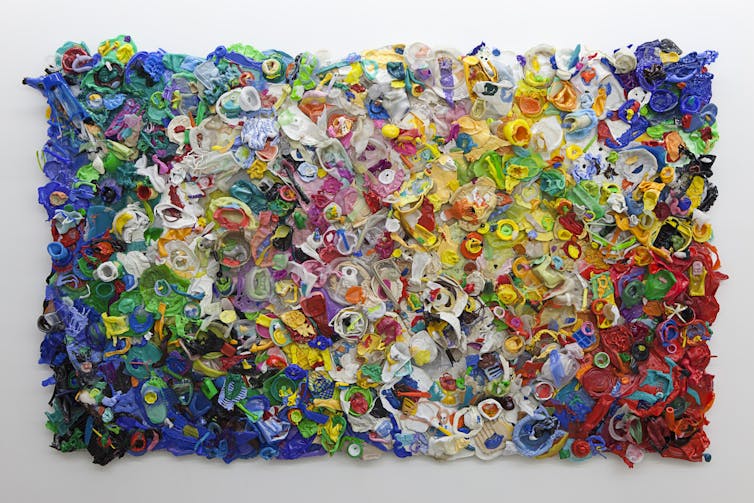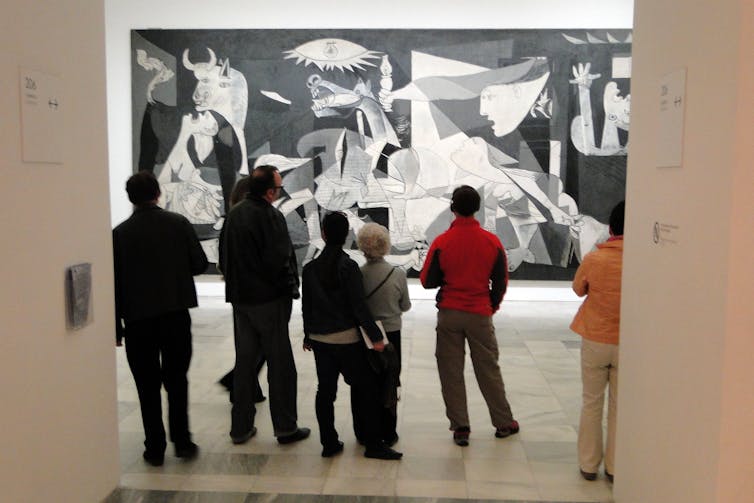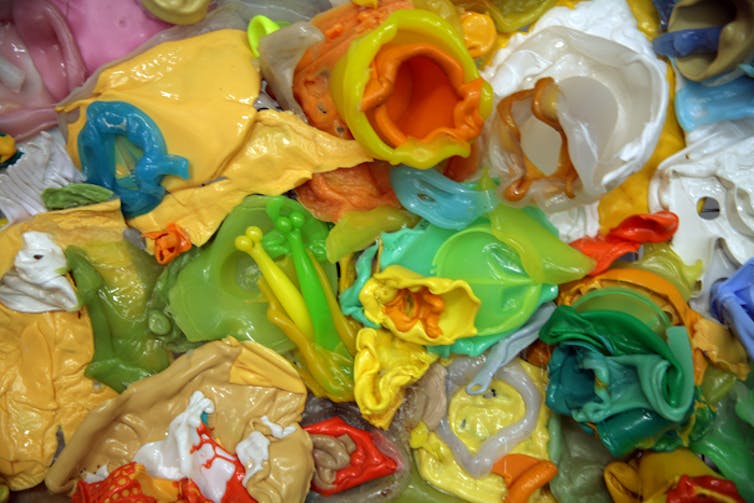What Is Essential According to Sayre When Trying to Understand the Meaning of Works of Art?
What'due south the key to understanding fine art? Could there exist some easy steps to unpacking the significant of an artwork?
The brusk respond is: yes.
I recently wrote an commodity for The Conversation chosen 3 questions not to ask of art – and four to ask instead, which tackled some age-old questions that get asked of art: Why is that art? What is information technology meant to be? Couldn't a four-year-old do that?
I suggested iv better questions to ask, taken from Australian art academic Terry Smith.
Here's a simple iii-footstep method I apply, adapted from an old technique by the art historian Erwin Panofsky:
1) Await
2) See
iii) Recall
The offset two – look and see – are just nigh using your eyes, and observational skills. The tertiary requires a bit of thought, drawing on what we already know and creatively interpreting what nosotros've observed within an artwork's broader contexts.
When we meet anything, whether it's a piece of work of art, a movie or a billboard, our brains perform a massively complex carve up-second process of reading and making meaning. We absorb a whole range of clues that make up our understanding of whatsoever epitome, many of which we're not even conscious of.
Any process of understanding fine art, then, is about slowing down that process, breaking downwardly the prototype deliberately and property off from jumping to any snap conclusions until after.
Step 1: Expect
Isn't it obvious we "wait" at fine art? Not actually. When we visit a gallery, we tend to spend only a few seconds in front end of any one work. In fact, some estimates have information technology at under two seconds.
So look at what's there, literally right in front of you lot. Start with the almost basic: what medium or material is it – a photo, an object, a painting? How does information technology look? Rough and quick? Slick and neat? Shiny? Dirty? Carefully made? Thrown together?
The artist will accept made some very deliberate decisions nearly the materials, style and approach, and these will feed direct into the overall feel and meaning of the work.
Expect at this work by Spanish-born Australian artist Dani Marti called It's all nearly Peter, made in 2009.

It hangs on the wall similar a painting, but is made up of hundreds of melted plastic objects bowls, orange juicers, plastic domestic appliances, all different colours. Marti wants us to recollect of it in the tradition of a painting, fifty-fifty if it's made up of 3D plastic objects.
Step two: See
What's the difference betwixt looking and seeing in the context of art? Looking is about literally describing what is in forepart of you, while seeing is virtually applying meaning to it. When we see we understand what is seen as symbols, and we interpret what's at that place in front of us.
Erwin Panofsky calls the symbols in an artwork "iconography", and any image can exist easily broken down into the iconography that makes it upward.
Consider the iconography in Pablo Picasso's epic painting, Guernica (1937). In the centre, there's that screaming horse, with a dismembered arm but below it. On the left, a woman is wailing and holding a dead infant, and dominating the image is the low-cal shade that looks similar an explosion. Those private elements combine to produce the overall meaning of the painting, which in this case is regarded every bit one of the nigh powerful anti-war fine art works created.

The iconography in Marti's It's all most Peter is not and so obvious – it'due south more than abstracted, which ways it's removed from a elementary literal depiction of something. Only the actual melted plastic objects are everyday items – things you might take in your habitation, the objects a person would surround themselves with that make upward their life. Make a mental note of iconography like this, and have it to the last step.
Step 3: Call up
The concluding step involves thinking most what you lot've observed, drawing together what you lot've gleaned from the first two steps and thinking about possible meanings. Importantly, this is a process of interpretation. It's non a science. Information technology'southward not about finding the "right answers", simply about thinking creatively about the most plausible understandings of a work.
The key here is context. The broader context of an artwork will assist make sense of what you've already observed. Much of the information almost context is usually given in those irksome little labels that tell you the creative person'south name, the title of the piece of work and the year. And there are often other valuable morsels of information included too, such as the identify and year an artist was born.

Who is the artist? Is it someone whose work you know something about? If and then, what do yous know near them? Even if this is "Picasso was a womaniser", or "Jackson Pollock was a drunk", if you've heard of the creative person, you have some existing knowledge you can bring to acquit.
If you've never heard of the artist, what does his or her proper noun suggest about where they might be from? Text panels in galleries usually have the artist's dates and where he or she was born. These are of import clues. Naturally, an artist built-in in the Soviet Union in the 1930s is going to accept very dissimilar life experiences from one built-in in Spain in the 1960s.
When was the work fabricated? What exercise you know about what was happening at the time, fifty-fifty if information technology's this year? Text panels sometimes say where the creative person works, so where was the work made? Artists produce work that responds to the world they're immersed in every twenty-four hours, and then the "when" and "where" volition give clues as to what was happening.
Importantly, bring to carry everything you know – you'd be surprised how much you know of the context of an artwork just from your general knowledge, a lot of which comes from conversations, goggle box, the internet, all those things that are "informal learning".
In the case of Marti'southward It's all near Peter, the title is a major central. Marti is literally telling us that this work is all nigh someone called Peter. We might non know who Peter is, just nosotros practise know from the title that this is a kind of an abstracted portrait of him – recall of how the artist has hung this on the wall like a painting, wanting united states of america to think of the tradition of portraiture.
The iconography – those everyday plastic objects in this work – are a portrait of "Peter", mayhap things owned by him, that say something almost the colours of the things he chooses to surround himself with. If this work was a person, what could you say about them? Colourful and complex, perhaps? We're guessing. But we've unlocked that It's all about Peter is a personal portrait near the artist'southward connectedness with Peter.
Hold on …
You might be thinking, "concord on, if I did these three steps every time I run into a work of art, information technology's going to take years to encounter everything in the gallery".
So hither's an of import tip – you don't have to look at (or like) everything. Yous don't like those Old Chief paintings of rich dead white people? Fine, don't waste your fourth dimension on them. Alternatively, if yous love that stuff and hate modern art, become wild.
Trying to see everything in a major gallery in an 60 minutes is like going to a multiplex picture palace and trying to come across all 12 movies in an hr by dashing from theatre to theatre. Nothing would make sense.
Myself, I love art that pokes me to think differently most something I thought I already knew. Other people prefer eye candy. It'south all valid.
Only requite yourself a moment to dull down, to look, see and think, and you lot'll detect something that really speaks to you.
Source: https://theconversation.com/three-simple-steps-to-understand-art-look-see-think-33020
0 Response to "What Is Essential According to Sayre When Trying to Understand the Meaning of Works of Art?"
Post a Comment